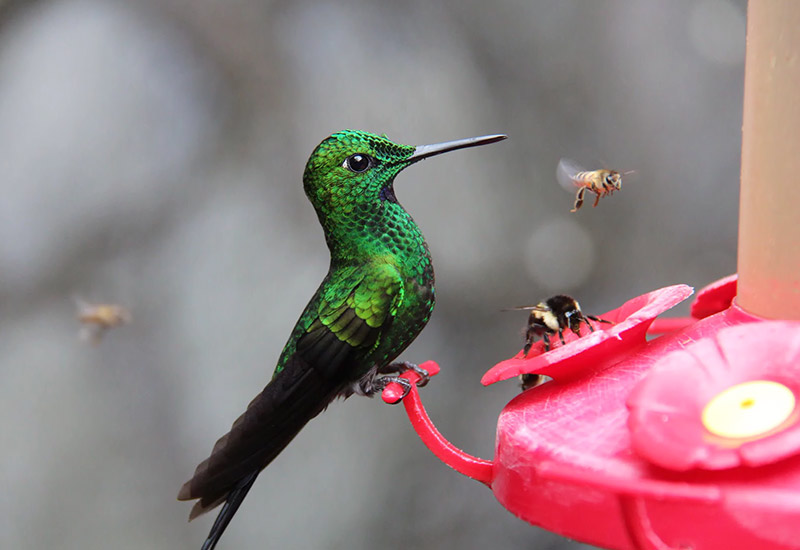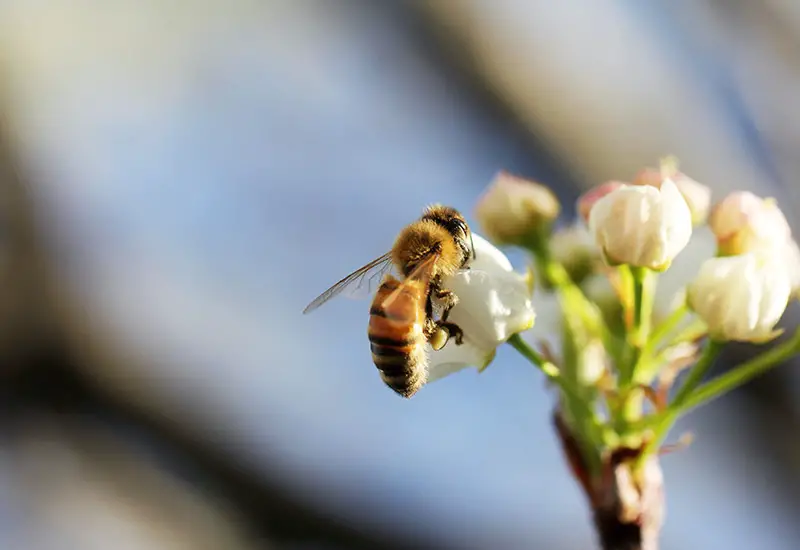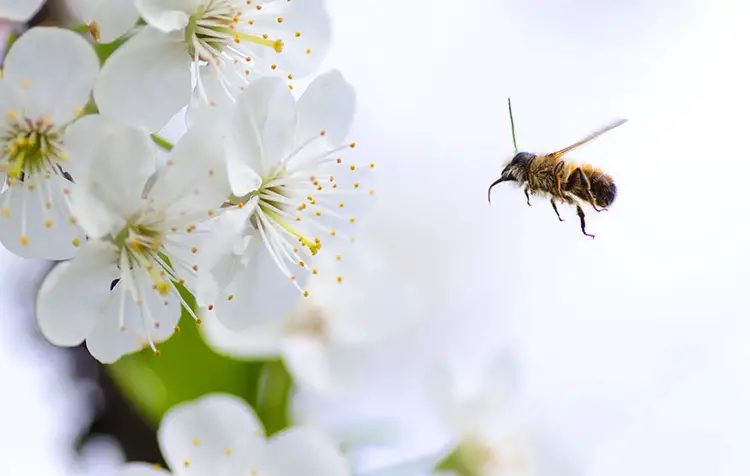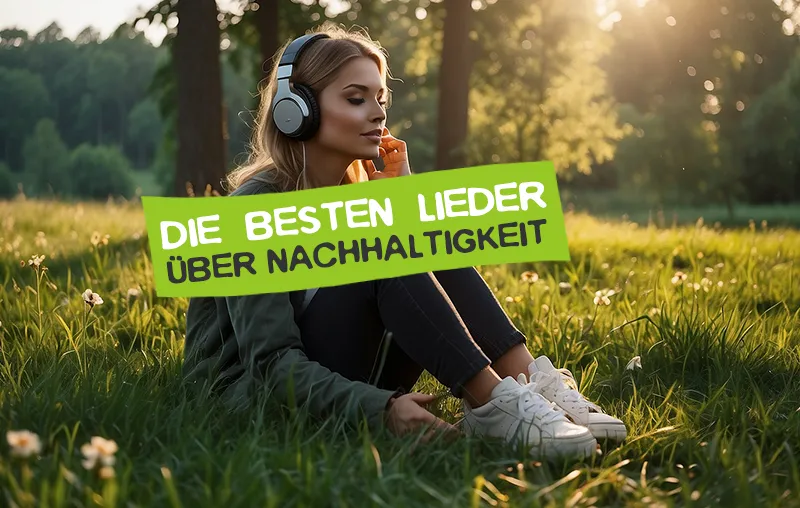How does pollination of plants actually work? Without the fertilization of flowers, most plants would not be able to form fruits and seeds - or reproduce. Fortunately, nature, but especially bees, flies and countless other insects, quietly and secretly perform this valuable work, which is essential for life on this planet. Put simply, the less it hums, the fewer plants grow - and the lower the choice and quality of the food we humans eat.
In this article, I would like to briefly and concisely explain plant pollination - from the definition, forms, processes, animals and their pollination performance, to the importance for our lives. Let's go!
Here you can find a short overview in advance:
What is pollination in the plant world?
With the pollination is generally the Transfer of pollen to the stigma of the carpel of the flower of another or even the same plant. meant. The pollen sticks there and fertilizes the egg cell. This process is the prerequisite for fertilization of a plant so that it can form fruits and seeds and reproduce.₁
What are the types of plant pollination?
Basically, the forms of plant pollination are divided into cross-pollination and self-pollination. Here I would like to explain briefly and concisely how plants are usually pollinated.
One thing in advance: It is a common misconception that plants can only be fertilized by insects.
Through animals (zoophilia)
So-called zoophilia is a form of cross-pollination. Plants attract the bees, beetles and other small animals by their eye-catching appearance or interesting fragrance to which the pollen adheres when touched.
e.g. bees, beetles or birds
By wind (anemophilia)
Anemophily is also cross-pollination. However, countless plants are fertilized without animal involvement - namely by the wind. The wind blows the pollen from plant to plant. This works because wind-blooming plants Oodles of pollen and thus have a high probability of cross-pollination. Finally, the large number of pollen in many people also leads to Allergies.
e.g. grasses, stinging nettle and pine
Through water (hydrophilicity)
There is no wind in the underwater world. Instead, other natural forces prevail there, which plants make use of. Many underwater plants reproduce primarily with the aid of Currents and waves away. This is also a form of cross-pollination.
e.g. algae
Notice: Many aquatic plants have their flowers on the water surface. This is the case, for example, with the flooding buttercup. Its pollination is carried out by insects or by self-pollination.
Through humans (antropophilia)
As might be expected, we humans have also developed a form of cross-pollination to artificially propagate plants. Above all, to create a faster plant breeding and not be dependent on random, natural pollination - but also out of necessity. Because the Insect mortality contributes decisively to a decrease in pollination performance and thus also in crop yield.
e.g. by human hand with a brush or with robots and drones; already necessary today in many parts of China (see here)
Through self-fertilization (autogamy)
Many plants are also capable of self-fertilization. They produce pollen in their anthers and transport it directly to the stigma of their own flower. This autogamous way of reproduction is accordingly considered self-pollination.
e.g. blackberry, strawberry, barley, bean and pea
Which animals pollinate which plants?

Wind, water, human hand - the described forms of plant pollination are relatively self-explanatory. But the pollination by animals of course leaves the question open, who exactly has adopted to pollinate plants. Here I have compiled a small list of animal "pollinators" for you:
- Wild bees (e.g. coffee, strawberries, apples, canola or pears)
- Honey bees (e.g. thyme, raspberry or wild rose)
- Ants (e.g. buckwheat or cherries)
- Flying (e.g. cherries, fennel or pears)
- Wasps (e.g. ivy or brown and ragwort).
- Butterflies (e.g. buckwheat, spring vetch or horn clover).
- Moths (e.g. honeysuckle or buttercup)
- Beetle (e.g. cherries or angelica)
- Hummingbirds (e.g. fuchsias or cacti)
- Gecko (e.g. for New Zealand flax)
- …
In the course of evolution, insects in particular have adapted perfectly to their work performance in nature - and many plant species have also developed strategies to attract the animals that are able to pollinate them.
How great is the pollination service of animals?
Now we know a lot about pollination itself - but how important is this process actually? Are we humans really dependent on the work of insects or the wind? Here are meaningful facts and figures around plant pollination:
- Up to 85 percent of agricultural yields in plant and fruit cultivation in Germany depend on pollination by bees.₂
- Bees pollinate around 72 percent of the 100 most important crops in Germany.₂
- In one day, a honey bee flies out up to 30 times and visits 200 - 300 flowers per flight.₃
- The economic benefit of pollination services is around 2 billion euros per year in Germany and 70 billion U.S. dollars worldwide.₄
Why is plant pollination by insects so important in particular?

Without pollination by bees, flies, beetles and other insects, only a small proportion of wild and culturally cultivated plant life could reproduce. But especially the climate change, the sealed, over-fertilized and poisoned soils, the intensive agriculture and forestry, as well as private, gray gravel gardens, deprive the animals of their livelihood. As was to be expected, the Number of most insect species rapidly decreased and made the scenario of a world without insects more realistic.
A scenario, by the way, that has fatal consequences for natural ecosystems and for us humans. Without the pollination services of insects, there is less shelter and food for numerous creatures. In addition, insects themselves are an important source of food for birds, which is why their decline also quite fundamentally affects the global species extinctions drives.
In addition, a large proportion of the most commonly grown crops rely to varying degrees on animal pollination. For example, the Crop yields of strawberries, cherries, coffee or rapeseed slump by up to 90 percent.₅
We humans are simply dependent on plant pollination by insects. And for that reason alone, we must do everything we can to ensure that the Stop insect mortality.
Plant Pollination - Of Essential Importance for (Survival) Life on Earth
Almost unnoticed, animals do a great job that is crucial for life on earth. Pollination of plants creates cover and shelter for animals - and a broad, plant-based food supply for all living things, including us humans. This makes it all the more alarming that the number of insects is falling to the ground.
What you can do about it as an individual? Here are some more in-depth articles that might make your life a little more pollinator/insect friendly:
I hope that I could help you with this article about pollination of plants. Do you have any questions, tips or suggestions? Then I look forward to your comment.
Stay sustainable,

PS.: With a sustainably landscaped garden you can, for example, help to increase the number of insects and thus also the pollination performance. You can find out how this works in practice in the linked article!
References:
₁ University of Hamburg: Pollination, available at https://www.sign-lang.uni-hamburg.de/galex/konzepte/l70.html. [13.04.2021].
₂ Romina Rader, Ignasi Bartomeus, Lucas A. Garibaldi (2015); et al: Non-bee insects are important contributors to global crop pollination, available at https://www.pnas.org/doi/10.1073/pnas.1517092112 [13.04.2021].
₃ Deutscher Imkerbund e.V.: Bienen als Bestäuber - Der Vorgang der Bestäubung, available at https://deutscherimkerbund.de/164-Der_Vorgang_der_Bestaeubung. [13.04.2021].
₄ Deutscher Imkerbund e.V.: Bienen als Bestäuber - Zahlen, die zählen - Bestäubungsleistung im Überblick, available at https://deutscherimkerbund.de/163-Bienen_Bestaeubung_Zahlen_die_zaehlen [13.04.2021].
₅ NABU - Naturschutzbund Deutschland e.V.: Kleine Tierchen mit großer Leistung, available at https://www.nabu.de/umwelt-und-ressourcen/oekologisch-leben/balkon-und-garten/tiere/insekten/22683.html. [13.04.2021].






I admit it: when I read the title of this post (on trusted blogs, by the way), my first thought was, "Seriously? An article about pollination?" - And now I have to say: chapeau! I learned quite a bit and think this post is really great. Thank you for this, Christoph!
Best regards
Eddy
Comments are closed.